I love to eat, but admittedly do not cook much. I am the chef’s sampler indeed, but not a chef.
There is one thing connected to the great outdoors regarding cooking that truly intrigues and amazes me though – Dutch oven cooking.

I have been around Dutch oven cooking for some time, but have been the beneficiary of the culinary talents of many.

Over the years, we have had fabulous Dutch oven cooks associated with the Nebraska Game and Parks Commission – Carl Wolfe, Steve O’Hare, Jeff Fields, Lynn Hartog, Alette Hain, Jo Momsen, Julia Plugge, Julie Geiser, Donna Robinson, Peggy Kapeller, Tammy Crosby, Tiffani Gerber, Sarah Heiden Johnson, Christy Christiansen and more.
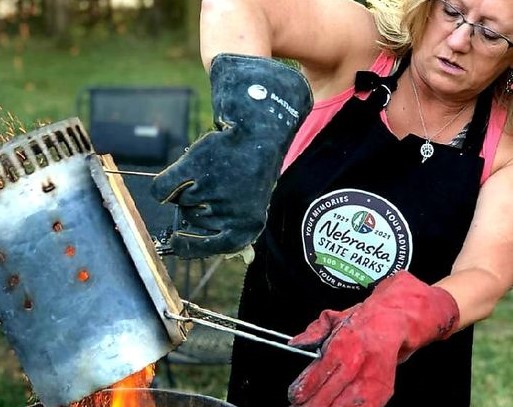
It seems there is so much to know about cooking with a Dutch oven. That heavy, cast-iron, deep-dished cooking pot with its three legs and rimmed lid can sure be intimidating. Not to mention what you have to do with all those charcoal briquettes!
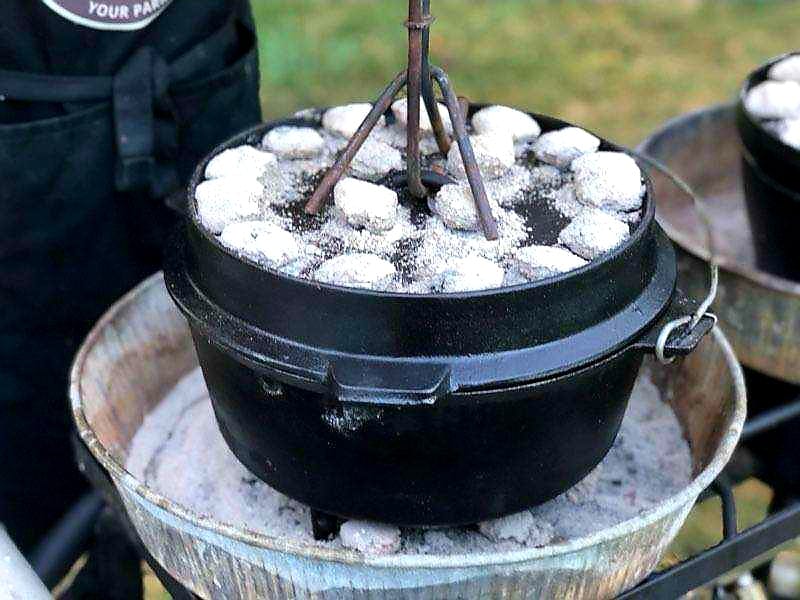
For specific information about Dutch oven cooking, I turned to longtime friend, avid outdoor enthusiast and Nebraska Game and Parks Commission colleague – Christy Christiansen. You see, Christy, a fellow Bellevue University alumni, is an outdoor education specialist with our agency and a real pro at Dutch oven cooking.
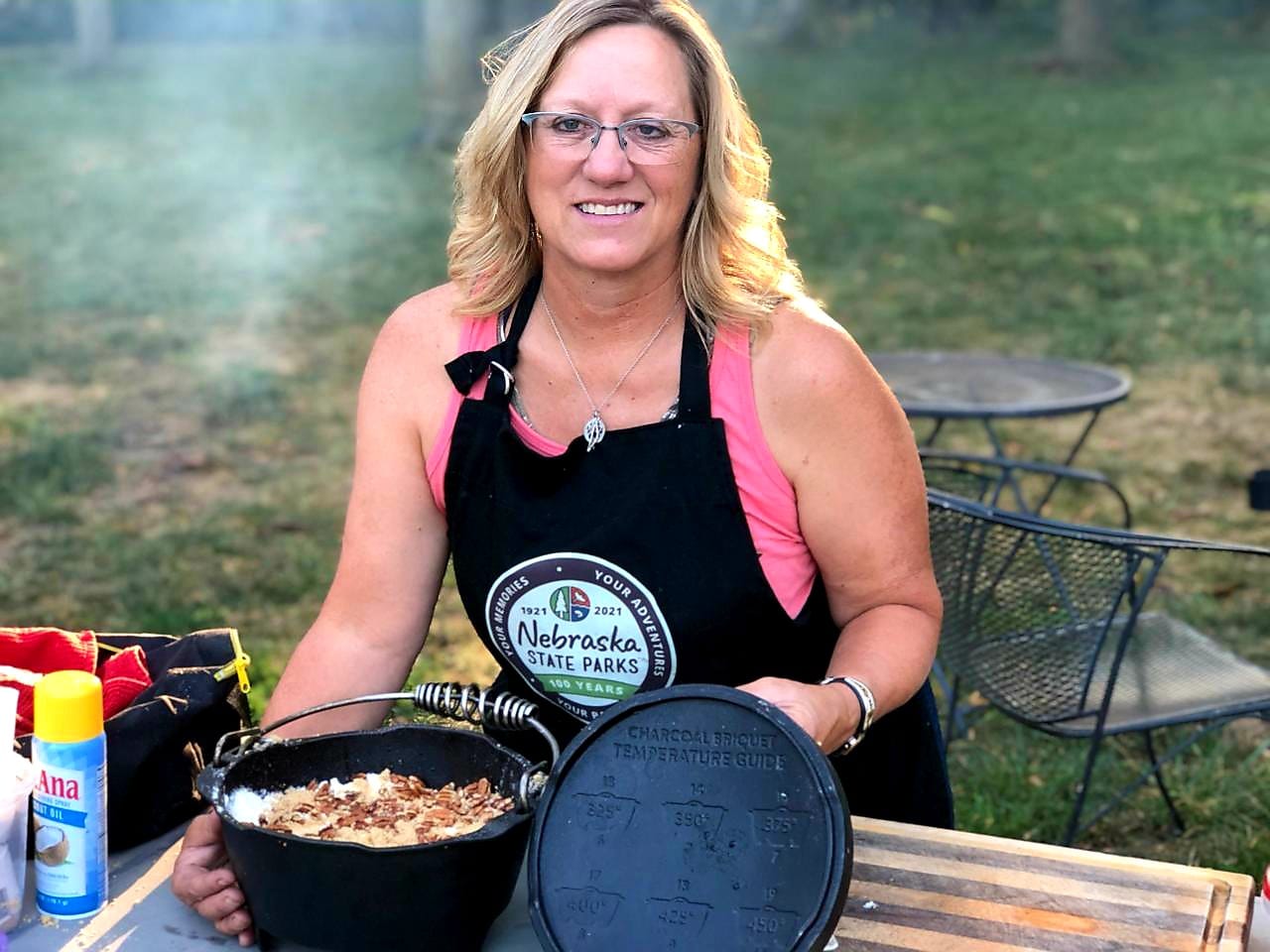
She offered to demystify and simplify the rewarding and delicious art of Dutch oven cooking and offer up some tasty recipes as well.
So here is my Q & A (question & answer) session with her about the basics of Dutch cooking that you’ll find very helpful.
GW: What do I need to know about buying a Dutch oven?
CC: A Dutch oven is intended to cook with coals on top and underneath to create an oven effect of the heat surrounding it. Make sure the oven lid has a lip around the edge to keep the coals from falling off and 3 legs. If you have one without legs you can use a trivet made for a Dutch oven. A good size for a cast iron Dutch oven is 12-inches and can feed 6-8 people. A 10-inch Dutch oven is great for cobblers. Well-known brand-names are Lodge, Wagner, Cabela’s, Camp Chef, Coleman and Texsport. Don’t pass up an old rusty oven you find at a yard sale. Just a bit of elbow grease will bring it back to brand new.
GW: Do I need to season the Dutch oven?
CC: Most new Dutch ovens are pre-seasoned or cured but like everything else you buy, it will need a good scrubbing. The first time you use one, you can use soap (BUT JUST THIS ONE TIME!). Wash and scrub thoroughly with a scrub pad. Heat, dry and coat inside and out with Crisco or another cooking oil and and you are ready! Best to cook bacon or hamburger for the first entree, too. The excessive bacon and burger fat will further help to season the oven as it gets hot.
GW: Is a Dutch oven complicated to use?
CC: No, not at all! If you like making one-pot meals it is an excellent, easy way to cook. The Dutch oven, called the world’s greatest pot, is safe, durable and versatile. It heats evenly and holds in moisture and flavor.
GW: What are the key things to know about cooking with Dutch Ovens?
CC: Learning how to determine and maintain temperatures are the big keys. Buy a better brand of charcoal briquettes like Kingsford. For getting the briquettes hot, use a charcoal chimney starter. The advantage of a charcoal chimney starter is that you can get the coals started quickly and heated as evenly as possible.
Use the Dutch oven rules of thumb for cooking with charcoal. Have 2 or more briquettes or coals than the size of the oven on top and 2 or less underneath. The 12-inch oven has 14 coals in a circle on top and 10 on the bottom. The other rule: 1 charcoal briquette = 25 degrees. Most Dutch oven recipes call for cooking at 350 degrees.
Also, keep the lid on tight and try not to peek during the cooking process, remember this is an oven. It takes a while to heat up, but it maintains the heat well. Employ a lid lifter made for ovens or a hammer, wear welding gloves or thick leather oven mitts and no open-toed shoes. Think safety, be cautious and don’t burn yourself or start a wild fire!
If you have no way to properly contain your Dutch oven and charcoals for the cooking process, know that a round, large, galvanized poultry-watering pan works well for that. Farm-supply stores sell these 16-inch wide, 5-inch deep metal pans. When finished, make certain to cool all the coals with water.
A few more things to note.
For stacking Dutch ovens, three are common (add a 14″ on the base) but two can be used just fine. The bottom one is a 12″ and a 10″ is on top. Be sure to have a good amount of charcoal going when planning to stack them. The coals on the lid can be counted towards the coals of the bottom of the oven on top.
Keep in mind that your seasoned dutch oven lid can make a wonderful pan for cooking by setting it upside down on a bed of coals (great for cooking pancakes). Don’t submerse a hot oven in cold water because it can crack. Never leave food sit in the oven after cooking as the food will pull off the seasoning and can rust.
GW: How do I clean the Dutch oven?
CC: The best way to clean a Dutch oven after scraping out excess food and while the oven is still warm, is to pour water in the pot and scrape with a wooden spoon or spatula. You can always heat up the water if food is really stuck to it. Dump the water out and scrub it out with a green scruff pad and add water, if needed. Heat the oven up to dry and then coat with Crisco or similar cooking oil. I actually lean toward using shortening. One trick I learned recently is to wipe out the excess oil with a soft cloth/t-shirt before storing. This prevents the oven from getting sticky.
GW: Can I cook outside with Dutch ovens in late fall and winter?
CC: Absolutely! Cast iron is able to withstand wear and damage as long as it stays dry and is clean when stored. Keeping your dutch ovens in a storage bag made for them works really well. I place the lid on the bottom of the bag and set the oven on top. Place newspaper inside the oven to absorb any excess moisture. You can cook with Dutch ovens year-round, no problem.
GW: Are there limits to what I can cook in a Dutch oven?
CC: Anything you can make in your oven at home, you can make in a Dutch oven. There are no limits! Be inventive! I have made pot pies, pizza, bread, brownies and even enchiladas!
GW: What are the advantages of cooking with a Dutch oven at a campsite fire ring or in your backyard fire pit?
CC: I like the fact that you can leave it cook while you are doing other things. Backyard fire pits ring are great during late summer and early fall, so you won’t heat up the house when you really want to bake a cake or something else. Dutch ovens also mean less equipment to pack when camping. I bring one Dutch oven and a cast iron skillet and make just about every meal in them while we are camping.
GW: Can you cook on the stove with a Dutch oven?
CC: Yes, but if you are baking something you will want to put it in the oven. I use cast iron skillets and Dutch ovens daily at home. I prefer to utilize my gas range, but I do know several people who use electric stoves and even cook with them carefully on a glass top.
GW: What are among the better recipes for Dutch oven cooking?
CC: I like a mountain man-style breakfast with everything in it such as potatoes, bacon, sausage, onions, peppers, eggs and of course lots of cheese (see recipe below)! Many folks, including myself, enjoy making cobblers in Dutch ovens.
GW: Can you share some of your favorite recipes with us?
CC: Okay, these are some of my originals. The two-ingredient cobbler recipe belongs to one of our other DO (Dutch oven) cooking experts.
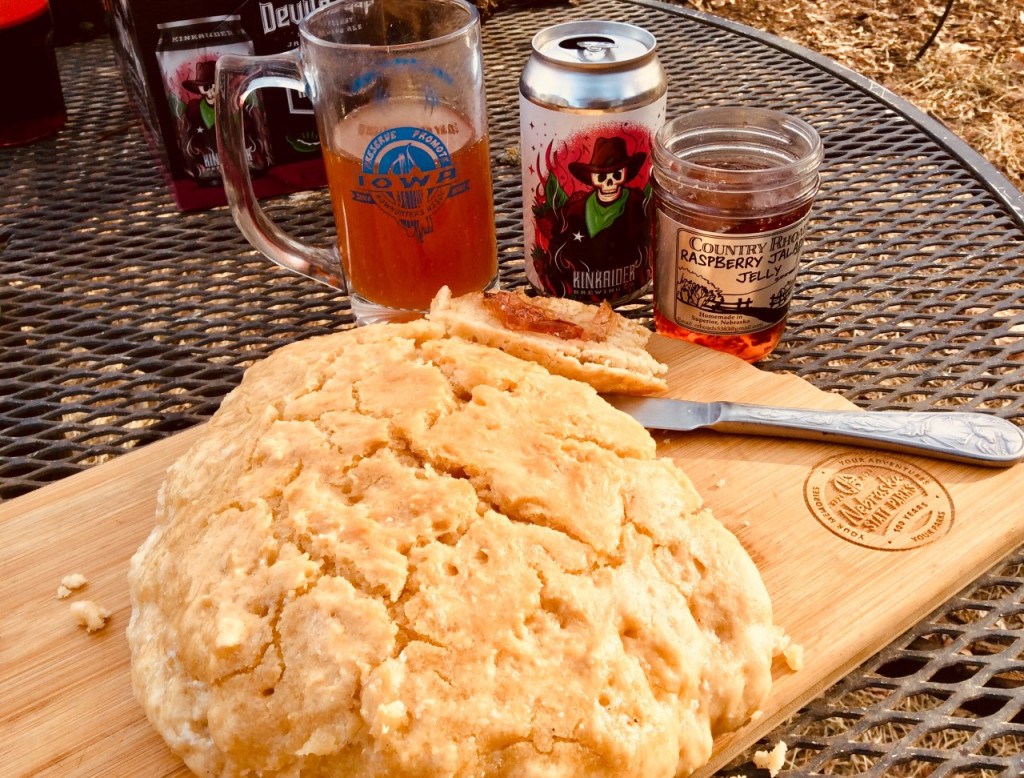
Simple Four-Ingredient Beer Bread
3 cups of self-rising flour
3 tablespoons sugar
12 ounce warm beer (any kind)
1/2 stick of salted butter melted
If you do not have self-rising flour just add 4 1/2 teaspoons of baking powder and 3/4 of a teaspoon of salt to all-purpose flour and mix it all well. It will be a thick texture. Coat the bottom of a 10″ Dutch oven with Crisco or Pam. Lining the oven with parchment paper helps keep the bottom from scorching and makes it easier to the lift the bread out of the oven. Dump the batter into the oven. Then, cover the DO with its lid and set it on a ring of 8 hot charcoal briquettes. Put 12 hot charcoal briquettes on the lid. Turn the oven after 15 minutes and line up the steam vents. Cook for an additional 15 minutes and pour melted butter over the bread. Bake for at least 5 more minutes or when the bread is brown on tap and sounds hollow when tapped. More hot briquettes may have to be added. Take off the hot briquettes and let sit with the lid off to cool. Bread is best served with butter or raspberry-jalapeno jam.
Mountain Man Breakfast
1 pound bacon or 1 pound of sausage or use both!
1 Large bag frozen cubed/diced hash browns
1 bag frozen onions & green peppers
1 dozen eggs
2 cups shredded cheddar cheese 1 8oz tub of sour cream (I prefer the flavored ones-Cheddar Bacon is my fave!)
Seasoning to taste
Cut up bacon and/or sausage and cook in a 12” DO until brown. Do not drain grease. Add hash browns and stir. In mixing bowl add eggs, cheese and sour cream & dump in DO (Dutch oven) and mix. (or not, just dump it all in!!)
Place 10 hot charcoal briquettes in a hog/feed pan in a
circle, place DO over hot coals, cover with lid.
Add 12-14 hot coals on top of DO. Stir after 15 minutes. Cook an additional 15-20 minutes and add more hot coals to top if necessary.
Christy’s ‘Ritzy Chicky’ Casserole
1 Rotisserie cooked Chicken
8 oz tub sour cream
2 cans cream of chicken soup
2 cans cream of potato soup
1 small bag frozen vegetables (opt)
Ritz crackers (2 sleeves)
1 stick butter
Seasoning to taste (mural of flavor)
Cut chicken in bite size pieces and place in DO. Add sour cream and soups and stir until smooth, add frozen vegetable (opt). Crush sleeves of Ritz crackers and spread on top of casserole. Melt butter and pour over top of crackers. Bake in Dutch oven at 350 degrees for 30-40 minutes.
Dutch Oven Apple/Pear Cobbler
1 cans Apple Pie filling
1 can sliced pears (do not drain)
1 butter pecan cake mix or yellow
1 stick of butter
Brown sugar
Small bag of pecans
Coat bottom of Dutch Oven with Crisco. Dump both cans of pie filling into DO. Cut into bite sized pieces. Pour cake mix over top of pie filling. Top with pats of butter, walnuts and sprinkle with brown sugar.
Cover with DO lid and set on a small ring of hot coals. Cover the lid with hot coals. Turn DO after 15 minutes to ensure even baking. Cook at about 350 degrees for 30-40 minutes, or until the cake looks done when cut or poked.
Dutch Oven Two-Ingredient Cobbler
2 cans diced Pineapple (do not drain)
1 angel food cake mix
or
1 can of pumpkin
1 spice cake mix *
*With this recipe you can add some extras-cinnamon chips, chocolate chips, top with pats of butter and sprinkle top with brown sugar.
Coat bottom of Dutch Oven with Crisco or Pam. Stir all ingredients together until well mixed.
Cover with DO lid and set on a small ring of hot coals. Cover the lid with hot coals. Turn DO after 15 minutes to ensure even baking. Cook at about 350 degrees for 30-40 minutes, or until the cake looks done when cut or poked.
Did you know
- American Patriot and Silversmith, Paul Revere, is credited with the unique design of the Dutch oven’s flat lid with a ridge for holding coals as well as the addition of legs to the pots of the Dutch ovens.
- George Washington himself was quite familiar with Dutch ovens. His army relied on them heavily as they spent years campaigning against British forces in the Revolutionary War.
- Lewis and Clark carried Dutch ovens on their journey across the American West in the early 1800s, and you can still buy reproductions of the three-legged ovens they used.
- Mountain men exploring the American frontier used Dutch ovens into the late 19th century.
- African American Settlers on the Great Plains widely used Dutch ovens for cooking.
- Chuckwagons accompanying western cattle drives also carried Dutch ovens from the mid-19th century into the early 20th century.
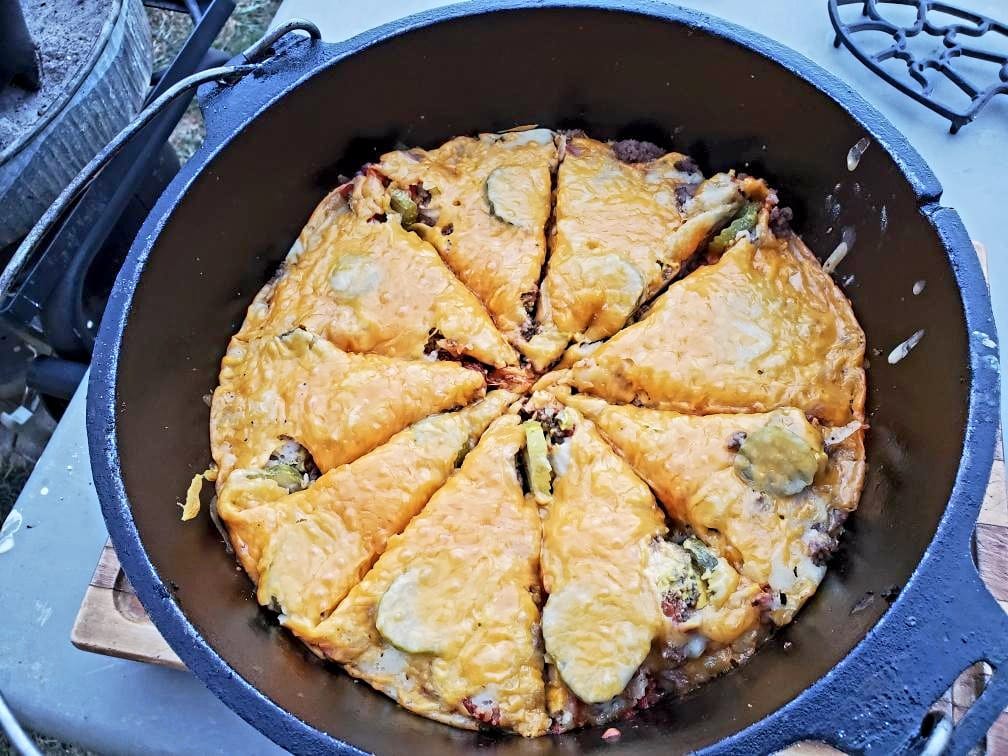
The post So what do you want to know about Dutch oven cooking? appeared first on Nebraskaland Magazine.
















